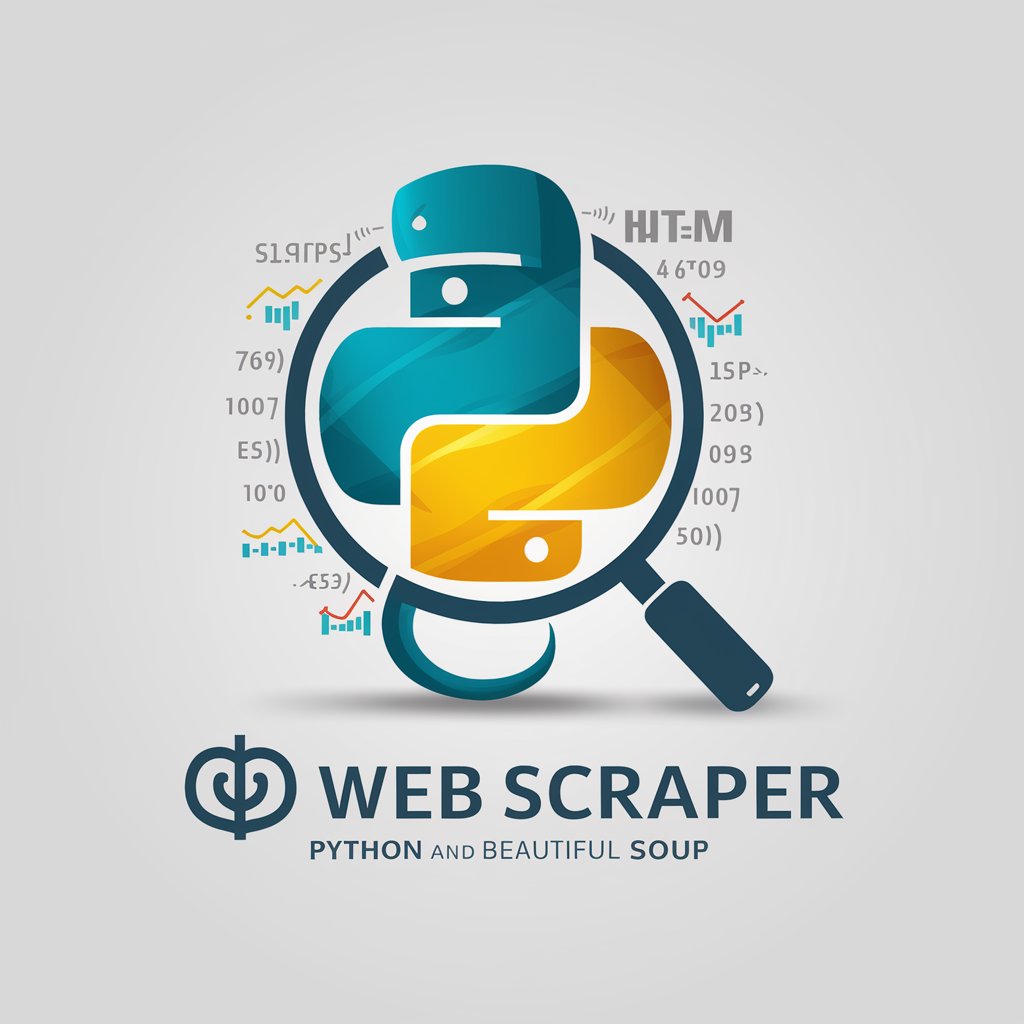
🌐 Web Scraper - Python & Beautiful Soup - Python Web Scraping Tool

Welcome! Ready to master web scraping with Python and Beautiful Soup?
Empower your data collection with AI-driven scraping.
Guide me through extracting data from a webpage using Beautiful Soup in Python.
How can I scrape data from a paginated website efficiently?
What are the best practices for ethical web scraping?
Can you provide a Python code example for handling login requirements while scraping?
Get Embed Code
Introduction to 🌐 Web Scraper - Python & Beautiful Soup
🌐 Web Scraper - Python & Beautiful Soup is a specialized tool designed to automate the process of extracting information from websites. Using the Python programming language and the Beautiful Soup library, it parses HTML and XML documents to collect data efficiently. This tool is capable of navigating through a webpage's Document Object Model (DOM), allowing users to retrieve specific pieces of data based on tags, classes, IDs, and other HTML elements. For example, it can extract all hyperlinks from a webpage, scrape tables to collect data for analysis, or gather information from dynamic pages that require parsing JavaScript. The design purpose of this tool is to simplify data collection from the web, making it accessible for data analysis, market research, content aggregation, and more, while promoting ethical scraping practices. Powered by ChatGPT-4o。

Main Functions of 🌐 Web Scraper - Python & Beautiful Soup
HTML Content Fetching
Example
Using Python's `requests` library to retrieve the HTML content of a webpage, then parsing it with Beautiful Soup.
Scenario
Gathering the latest news articles from an online news portal for a daily news digest.
Data Extraction and Cleaning
Example
Extracting product details from e-commerce sites, including names, prices, and descriptions, and cleaning the data to remove HTML tags.
Scenario
Competitive analysis for pricing strategy by comparing product prices across different e-commerce platforms.
Handling Pagination and Dynamic Content
Example
Automating the process of navigating through pagination or extracting data from dynamically loaded content via JavaScript.
Scenario
Scraping job listings from a career portal that loads more jobs as the user scrolls down the page.
Data Organization and Export
Example
Organizing scraped data into Python data structures like lists or dictionaries, and exporting the organized data to CSV or JSON formats.
Scenario
Creating a dataset of restaurant reviews and ratings from a food review website for sentiment analysis.
Ideal Users of 🌐 Web Scraper - Python & Beautiful Soup Services
Data Analysts and Scientists
Professionals who require large volumes of data for analysis, predictive modeling, or data visualization. They benefit from the ability to automate data collection, saving time and ensuring accuracy.
Digital Marketers and SEO Specialists
Individuals focused on market research, competitive analysis, and optimizing web content for search engines. They use web scraping to monitor brand mentions, gather SEO keywords, and analyze competitor strategies.
Academic Researchers
Researchers in need of specific datasets for their studies, such as social media trends, historical weather data, or economic indicators. Web scraping provides a method to collect these data efficiently.
Content Creators and Aggregators
Creators looking to curate and aggregate content from various sources for their platforms. Web scraping enables them to automate content collection and focus on content presentation and analysis.

How to Use 🌐 Web Scraper - Python & Beautiful Soup
Start with a Trial
Begin by exploring web scraping capabilities at yeschat.ai, offering a no-login, free trial that doesn't require a ChatGPT Plus subscription.
Install Dependencies
Ensure Python is installed on your system, then use pip to install 'beautifulsoup4' and 'requests' libraries for fetching and parsing webpage data.
Fetch Webpage Content
Use the 'requests' library to retrieve the HTML content of the webpage you wish to scrape. Handle the webpage's response appropriately to ensure it's accessible.
Parse HTML with Beautiful Soup
Create a Beautiful Soup object by passing the fetched HTML content to it. Use Beautiful Soup's parsing methods to navigate and search the document tree.
Extract and Organize Data
Identify the HTML elements containing the data you need. Use Beautiful Soup's methods to extract text or attributes, then organize this data as required for your application.
Try other advanced and practical GPTs
Turtle Soup Game
Solve mysteries with logic and wit.

Turtle Soup
Unravel mysteries, power your intellect.

We Both Like Soup
Nourishing your mood with AI-crafted soups.

Soup Maestro
Your AI-Powered Soup Kitchen

Soup Chef
Simplify Your Soup Making with AI

Chef Soup Jar
Craft custom, flavorful dried soups with AI.

Sensitive Skin Guide
Empowering sensitive skin with AI-driven insights.

Márcia Sensitiva 4.0
Humorous astrological insights at your fingertips.

Translate Buddy
Translating Languages with AI Precision

Thai Travel Tutor
Master Thai for travel, powered by AI

Kya - Culturally Sensitive Virtual Therapist
Empowering cultural empathy through AI.

Daily Guide for Highly Sensitive People
Empowering Sensitive Souls with AI

FAQs about 🌐 Web Scraper - Python & Beautiful Soup
What is Beautiful Soup, and why use it for web scraping?
Beautiful Soup is a Python library designed to simplify the process of parsing HTML or XML documents. It's widely used for web scraping because it allows for easy navigation of the DOM tree and extraction of data, making it ideal for tasks that involve collecting information from websites.
Can Beautiful Soup handle dynamic content loaded with JavaScript?
By itself, Beautiful Soup cannot execute or parse JavaScript. For dynamic content, it's often paired with Selenium or requests-html to render JavaScript before parsing.
How does one handle pagination with Beautiful Soup?
To handle pagination, identify the pattern or mechanism the site uses to navigate between pages. Then, programmatically modify the URL or payload in your requests to fetch and parse content from each page sequentially.
Is web scraping legal?
The legality of web scraping depends on the website's terms of service, how the data is used, and local laws. Always respect 'robots.txt' files and consider the ethical implications of your scraping.
How can one ensure data extracted is accurate and up-to-date?
To ensure data accuracy, regularly update your scraping code to adapt to changes in the website's structure. Implement checks within your script to verify the reliability of the extracted data.